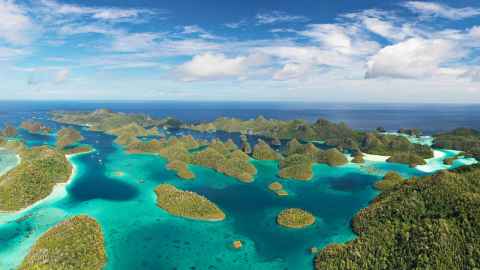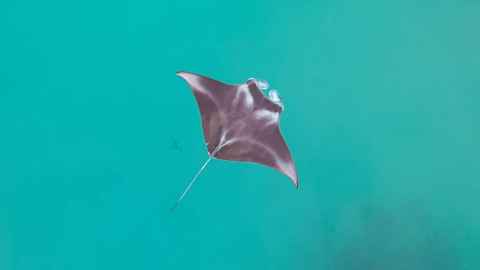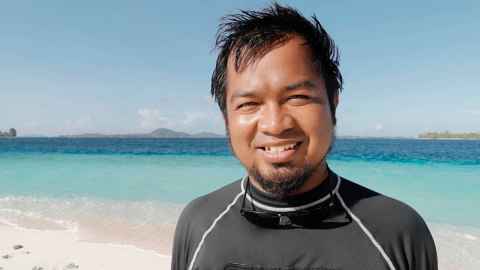Rare manta-ray nursery confirmed by University of Auckland scientist
31 May 2022
Eight years of tracking confirm that a lagoon site in Indonesia is a manta-ray nursery.

After eight years of study, scientists led by a University of Auckland researcher have confirmed the existence of a globally rare manta-ray nursery in the Raja Ampat islands in Indonesia.
The team’s research, just published in the journal Frontiers in Marine Science, is the most comprehensive description to date of a manta ray nursery anywhere, and is prompting the Indonesian government to take extra measures to protect the area, according to University of Auckland scientist Edy Setyawan. (A Youtube video summarises the study.)
Manta rays are graceful, gentle giants of the sea: highly intelligent and somewhat mysterious, with scientists only slowly learning more about their lives and habits. Oceanic manta rays are endangered and reef manta rays – the species in the nursery in Indonesia – are globally vulnerable to extinction.
One puzzle as scientists learn more about manta rays has been locating their nurseries. The research, and the growing expertise of Setyawan and his colleagues, has a special relevance to New Zealand because of suspicions that this country may host a nursery for globally endangered giant manta rays.
“We’ve seen pregnant females in New Zealand waters,” he says. “Moreover, we’ve seen courtship behaviour and fresh mating scars on some females in the Hauraki Gulf, and given the 12 to 13 month gestation period it seems likely that if they’re regularly in New Zealand waters in summer time they will give birth here.”
Citizen scientists can help out by reporting manta sightings to Manta Watch New Zealand.

At the Indonesian site, satellite and acoustic tracking showed newborn and juvenile reef manta rays had limited home ranges, staying for extended periods in the Wayag lagoon in the Raja Ampat islands. The young rays stayed nearly continuously in the lagoon for a year or more.
“Visual observations from 2013 to 2021 showed that juvenile reef manta rays were repeatedly encountered in this small, shallow and sheltered lagoon, without the presence of adult individuals,” says Setyawan. “Tracking data showed how these young rays spend months at a time inside the lagoon, never venturing out.”
Around the world, there are a limited number of places where scientists are studying juvenile manta rays: the Maldives, Palmyra atoll between Hawaii and American Samoa, the Gulf of Mexico off Texas and Florida, and Indonesia.
Scientists usually lack proof of long-term and continuous stays by the young rays, which is one of three requirements for confirming a nursery and best established by using satellite or acoustic tracking.
The Indonesian nursery, which is within a marine protected area (MPA), provides the rays with foraging grounds and “cleaning stations,” places on coral reefs where small “cleaner” fish feed on parasites on the rays.
“The authorities are already revising management of the lagoon to create a manta nursery zone,” says Setyawan. “Around the world, there’s much work to be done in confirming and protecting manta ray nurseries, and hopefully this study will encourage researchers and conservationists to take on more of these projects.”
Setyawan, a PhD student, led a team including scientists from Konservasi Indonesia, Conservation International, the University of Auckland, and Macquarie University.

“In the manta nursery zone, tourists and visitors will still be allowed to view and interact with the manta rays under a strict code of conduct, but no fishing is allowed,” says Setyawan. “Other regulations being formulated include limiting boat speeds to a maximum of five knots within the lagoon and stipulating specific areas where visiting yachts and boats can moor without disturbing the juvenile rays.”
The paper in Frontiers in Marine Science is entitled “Residency and use of an important nursery habitat, Raja Ampat’s Wayag lagoon, by juvenile reef manta rays (Mobula alfredi)”
Setyawan's research in Raja Ampat was supported by MAC3 Impact Philanthropies, David and Lucile Packard Foundation, Sunbridge Foundation, Wolcott Henry Foundation, SEA Aquarium Singapore, Save the Blue Foundation, Stellar Blue Fund, Russell E. Train Education for Nature Program (EFN), and New Zealand ASEAN Scholarship.
Media contact
Paul Panckhurst | media adviser
M: 022 032 8475
E: paul.panckhurst@auckland.ac.nz